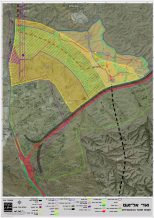Wadi el-Na’am

The village of Wadi el-Na’am, which is part of the Ramat Hovav Regional Council, was founded in the 1950s when Bedouin residents of the Negev were transferred there by the Israeli military. Since then, the locality has been considered “temporary,” and is not connected to water, electricity, sewage, telecommunication, or road network infrastructure, and its residents suffer from a severe lack of education, welfare, and sanitation services. Today, more than 11,000 residents live in Wadi el-Na’am.
In the past few decades, some of the worst sites in Israel in terms of environmental and health risks have been built near Wadi el-Na’am. The Neot Hovav Industrial Complex, which poses a real danger of putting nearby residents in contact with hazardous materials, produces harsh odors and severe air, soil, and water pollution, is only a few hundred meters from the locality. Dozens of high-voltage power lines were built in the locality, and east of Wadi el-Na’am there is a military industrial zone in Ramat Beka, which is used, among other things, for testing out all types of weapons.
For the past thirty years, state authorities have been negotiating with the residents of Wadi el-Na’am regarding selecting an alternative location for the village. Even though Wadi el-Na’am became a recognized village in 2016, the majority of the time the state has worked to force the residents to accept a solution to which they are opposed: forcibly transferring them to the town Segev Shalom.
The residents of Wadi el-Na’am are interested in regularizing and planning their village. They hope to establish a self-sufficient rural town that meets their needs, traditions, and way of life. Bimkom has been assisting them in this struggle from the beginning.
In 2015, Bimkom, along with ACRI and in full partnership with the Wadi el-Na’am Residents Committee, submitted a document for alternatives to the location and nature of the locality.
The village of Wadi el-Na’am, which is part of the Ramat Hovav Regional Council, was founded in the 1950s when Bedouin residents of the Negev were transferred there by the Israeli military. Since then, the locality has been considered “temporary,” and is not connected to water, electricity, sewage, telecommunication, or road network infrastructure, and its residents suffer from a severe lack of education, welfare, and sanitation services. Today, more than 11,000 residents live in Wadi el-Na’am.
In the past few decades, some of the worst sites in Israel in terms of environmental and health risks have been built near Wadi el-Na’am. The Neot Hovav Industrial Complex, which poses a real danger of putting nearby residents in contact with hazardous materials, produces harsh odors and severe air, soil, and water pollution, is only a few hundred meters from the locality. Dozens of high-voltage power lines were built in the locality, and east of Wadi el-Na’am there is a military industrial zone in Ramat Beka, which is used, among other things, for testing out all types of weapons.
For the past thirty years, state authorities have been negotiating with the residents of Wadi el-Na’am regarding selecting an alternative location for the village. Even though Wadi el-Na’am became a recognized village in 2016, the majority of the time the state has worked to force the residents to accept a solution to which they are opposed: forcibly transferring them to the town Segev Shalom.
The residents of Wadi el-Na’am are interested in regularizing and planning their village. They hope to establish a self-sufficient rural town that meets their needs, traditions, and way of life. Bimkom has been assisting them in this struggle from the beginning.
In 2015, Bimkom, along with ACRI and in full partnership with the Wadi el-Na’am Residents Committee, submitted a document for alternatives to the location and nature of the locality.
